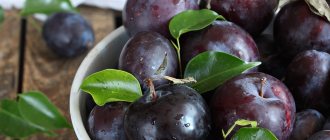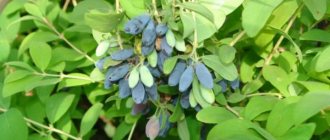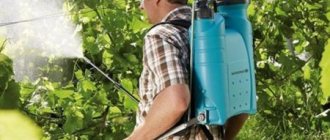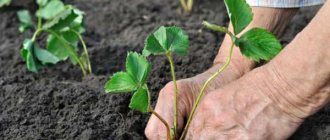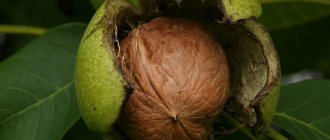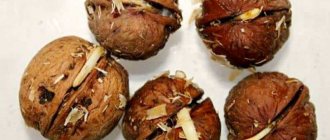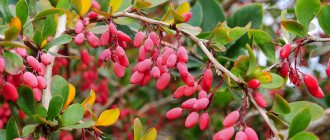Why prune walnuts in the fall?
At the end of summer or beginning of spring, shoot growth slows down, the plant prepares for cold weather. Autumn pruning makes the tree healthier.
Thanks to the procedure, all unnecessary parts of the plant are removed - dry and weak shoots, infected, thin and diseased branches. The walnut increases immunity, it is less susceptible to diseases and attacks by insect pests. Pruning prepares the tree for winter, so it can withstand frost and bear fruit abundantly next year.
Pruning improves the appearance of the plant - gardeners cut out all chaotic and intertwined shoots. After the procedure, the tree looks well-groomed and neat.
Is this necessary?
Autumn pruning is mandatory if gardeners want to improve the health of the tree, extend its life and receive a rich and tasty harvest every year. For mature trees, the procedure is necessary to increase the number of fruit branches.
If you do not prune the plant, the shoots thicken, the yield decreases, and diseases and pests appear more often. Weak branches break during the wind. It is difficult to rehabilitate such a tree; it takes several years.
Should I trim the branches?
The operation itself is stressful for the tree. Therefore, although it must be done, young seedlings under 2 years of age are not pruned, since their shoots have not yet grown sufficiently. Young trees are pruned carefully if their height has reached 1 meter.
If you do not trim the branches, the walnut crown grows chaotically, the greenery grows quickly, and the buds become weaker. By pruning, the branches become stronger. They grow in width, new shoots are formed, bringing more harvest.
Important!
Lack of pruning produces lush, overgrown foliage, but reduces yield.
Timing of autumn pruning
The timing of the procedure depends on when the walnut tree loses its leaves . This usually happens in September-October. When choosing a date, pay attention to the climatic conditions of the growing region and temperature.
Summer residents recommend pruning the plant on a cloudy and windless morning at a temperature not lower than +10°C. The procedure is not carried out in rainy weather.
Attention! Walnuts are trimmed 2-3 weeks after fruiting. If the inflorescences appear in May, then the harvest is harvested in early September. If in June, then the nuts are removed before the beginning of October. It is not necessary to wait for full ripening - the fruits are picked green and put in a box for 2 weeks.
Is it possible to process nuts in summer?
It is permissible to prune perennial walnuts in early summer. Approximately, this is mid-June. This period is characterized by less active sap flow. It is allowed to work on the crown, freeing the tree from branches that have grown inside.
But it is not advisable to touch a weak plant. Be sure to wait until the year the tree gains strength. Usually this is at least 2-4 years after planting. First, not 10, but only 5 shoots are formed on it, cutting off all the others in advance while the buds are swelling.
And on a two-year-old nut, all the branches are cut off, leaving only two buds. Moreover, one is the main one, the second is a backup one. And if both wake up, then only one is left. The next season follows the same pattern - only one kidney is left for the future. This is how they achieve good fruiting.
Even young trees have shoots cut off in the autumn season if they have grown above 60 cm. It is advisable to do this in September.
Kinds
There are several types of walnut pruning - rejuvenating, sanitary, shaping, regulating.
Each of them has its own purpose and is carried out in accordance with strict rules. Incorrect technique will do more harm to the plant than good.
Rejuvenating
Anti-aging pruning is relevant for trees older than 10 years, when the yield of mature plants gradually decreases, and the number of nuts becomes less and less every year.
During the pruning process, gardeners remove side branches, long new growth, and shoots growing into the interior of the tree. Thanks to the procedure, the life of the plant increases, and space appears for the development of new and fruit-bearing branches. The crown of the tree will take on the correct shape, and the nuts will become large.
The procedure is also relevant for those trees that consistently bear fruit poorly. Such plants are pruned every 7 years. The older the tree, the more intensive the pruning. Also, the rejuvenating procedure will save a tree that has suffered from frost.
Sanitary
Sanitary pruning is carried out if there are a lot of dry and weak shoots on the tree. They become deformed, become covered with stains and plaque, and change color. Such branches create a favorable environment for the development of diseases and the proliferation of pests, so the sanitary procedure is the prevention of their occurrence.
The event also restores the strength of the plant if it has already been ill. Most often, walnuts are affected by marsoniosis, bacteriosis, and brown spot.
This is interesting:
How to grow macadamia nuts at home
Cashew nuts - benefits and harm for women
What nuts are the healthiest for women?
Formative
Formative pruning is aimed at stimulating the growth and development of healthy shoots and increasing yield. Thanks to the procedure, the walnut's immunity is strengthened, the crown becomes powerful and resistant to external factors.
Formative pruning is also used when young plants need help with crown formation. It is important that the tree grows evenly in length and width, and that new shoots are evenly distributed along the skeletal branches. The procedure is carried out in October, when sap flow ends.
Attention! During formative pruning, gardeners shorten the middle trunk and all skeletal branches. This is necessary in order to get a new skeletal branch if one of the existing ones is damaged.
Regulatory
Regulatory pruning is carried out from 7-8 years after planting. By this time, a large number of small shoots and lateral processes have been formed in the crown, which interfere with normal fruiting. The leaves do not receive the required amount of sunlight and obscure each other and nearby growing shoots.
Summer residents recommend cutting out the semi-skeletal branches of the lower tier and thinning out the crown. Shoots with mechanical damage and wounds are also removed.
WALNUT TRIM. Nut formation, second year after planting
Features of planting columnar apricots
Both apricots and hybrids bred through selection are demanding of light and love the sun. In the absence of such conditions, if fruits are set, they will be in small quantities, and the taste will sharply deteriorate. Trees bloom very poorly in the shade.
You don’t need a lot of space for a columnar apricot, so you can always find a small area where the cold wind does not hit and there are no drafts. It is easy to plant a tree between buildings at a distance of 20-15 centimeters from them, but so that no shadow falls on it. Apricots should not be placed in lowlands, where both melt and rainwater stagnate and cool and humid air accumulates. The tree will be comfortable if you find a place for it at the foot of a gentle slope.
In the southern regions, columnar apricots are planted in open ground in both October and April. In the fall, it manages to take root and get stronger before the cold weather arrives no earlier than December. In the middle zone, trees are planted only at the end of spring or in the first month of summer, since frosts are a frequent occurrence here, and the hydrometeorological center is not able to predict when they will come.
Apricots develop poorly and often get sick in the place where they used to grow:
- tomatoes and peppers;
- raspberries and strawberries;
- potatoes and eggplants.
Such crops are attacked by helicopters and infect fruit trees with fungi. It is very difficult to cope with the pathogen. Apricot seedlings, preferably 2-year-old ones, are placed at a distance of 80 cm-1 m, leaving at least a meter between rows. Trees take root well on loose soils, permeable to moisture, and grow on loams, gray soils and chernozems.
It is advisable to buy seedlings in special nurseries that are located in your area, since the apricots that they sell are adapted specifically to this climate. The height of the tree should be within a meter. It is necessary to check whether the roots bend, whether the seedlings have healthy bark, and whether there is a trace of grafting. You should not buy apricots grown from the seed.
The hole for the tree is prepared in the fall. Both its depth and width should be within 60-70 cm. To prevent the water from turning sour, expanded clay or small crushed stone is poured onto the bottom in a 40 mm layer, after which wood ash or mineral fertilizers in the form of urea, superphosphate or potassium nitrate are added.
The top layer of earth is mixed with humus and sand, placed at the bottom of the hole, a support for the tree is installed nearby and covered, and in the spring:
- Make a hole in which the apricot is planted vertically.
- Pour and compact the soil, leaving a root neck of about 5 cm above the surface.
- A furrow is made along the tree trunk, sprinkled with peat or straw.
- The tree is attached to a support and watered with 2 buckets of warm water.
In order for the columnar plant to take root faster, the roots are soaked in a solution of potassium permanganate or a biostimulant, after which they are shortened a little and dipped in mash made from clay and manure.
Formative pruning schemes
The crown is formed according to a leader, tiered, cup-shaped pattern.
The leader technique is a method of distributing frame branches around the tree trunk in a spiral. The side branches are left on the lower 3 tiers until fruiting begins, after which they are thinned out until they are completely removed. Thanks to the leader pattern, the crown is well lit from all sides, which helps to increase productivity.
When pruning in layers, 3 frame branches are left on each tier, the distance between which is at least 15 cm. An adult tree should have about 5-6 tiers. The lower one is removed during the procedure - no branches should grow up to 1.5 m above the ground. During tiered formative pruning, the crown is thinned out.
They resort to a cup-shaped pattern to make harvesting more convenient. The bowl-shaped crown allows air to pass through, creating favorable conditions for fruit development. Pruning is carried out for 3 years, annually removing the central branches until the tree has 4 skeletal branches at a distance of 30 cm from each other. The remaining shoots are crossed with the branches of the upper tiers.
Timing of work
There are several favorable periods when walnuts can be formed. Walnut pruning is carried out in spring, summer or autumn. The most favorable period for crown formation is summer, or more precisely, July-August. Cuts after summer pruning heal faster, and the tree does not get sick for so long. Also during this period, the intensity of sap flow quickly returns to normal.
Pruning after winter
The first time a year, walnuts are pruned in the spring, after warm weather sets in. It is not recommended to carry out the procedure until the temperature outside is above zero, even at night. In the spring, rejuvenating pruning is carried out, which is aimed at forming the crown and its renewal.
In spring, the procedure is carried out in March-April. During this period, the nut tolerates the procedure more easily. Spring crown formation is carried out after the height of the tree is 1.5 m. Particular attention should be paid to the formation of the young seedling.
Green walnut pruning in summer
The summer procedure is aimed at removing branches damaged by diseases or pests. Formative pruning is also carried out in the summer if it was not done in the spring. In the summer, the “haircut” scheme is used. This type has the best effect on fruiting. But in summer, walnuts are pruned once every few years.
Autumn pruning
In autumn, a sanitary procedure is carried out. Trim the tree after it has shed all its leaves. The procedure is carried out as early as possible, before the crown has time to form in a chaotic manner. Trim dry and diseased branches. If the walnut is already a mature tree, then you will have to remove fairly large branches. And for the plant this is a lot of stress.
Preparing a nut for trimming
Work begins only with trees taller than 1.5 m. After fruiting, the walnut is watered one last time and the ground is loosened so that the moisture is better absorbed. Fertilizer is not applied in the fall; it is better to do it in spring and summer.
Summer residents pay attention to ensuring that the tree is free from insect pests and diseases. If there are signs of damage, then the plant is first treated and only then the procedure begins. Gardeners also monitor the cleanliness of the garden area - it should be free of debris, weeds and plant debris. Fallen leaves are collected and burned.
Processing large cuts on wood
There is an opinion that it is better not to process any pruning, to leave all the places as is for healing naturally. However, experts advise carrying out preventative measures for walnuts to prevent infection with fungus and other diseases.
Various solutions are made for processing, including:
- sugar based - 1 tbsp. add 2.5 tsp of water. Sahara;
- honey - 1 tbsp. dilute water with 3 tsp. honey;
- potassium permanganate.
The gardener needs to treat the pruning areas immediately, since the surface is subject to oxidation even in winter
Cutting branches from a walnut tree is a difficult job to prepare for. When working with young trees, it is necessary to monitor any action; even one wrong step can destroy the nut. Timely pruning gives high yields and long-term fruiting.
How to properly trim a walnut in the fall
To prune walnuts in the fall correctly and without harm to the plant, gardeners prepare tools in advance and study the instructions.
Required materials and tools
To remove green shoots and thin young shoots, use garden shears or sharp-edged pruning shears. A blunt instrument will harm the plants - it leaves torn cuts on the walnut tree, they take a long time to heal and serve as a breeding ground for the development of diseases and pests. The handle of the gardening tool should fit snugly in your hand and not slip off. The rubberized handles are comfortable. Before use, equipment is disinfected in a weak solution of potassium permanganate.
To trim thick and old branches, use a hand or gasoline saw. If the branches are located high, use a ladder and a lopper with long aluminum handles. Experienced gardeners recommend paying attention to personal safety rules.
Attention! For any type of pruning, a garden varnish is required. This is a thick, soft substance based on tree resin. Garden varnish protects cuts from bacteria and microbes and promotes rapid healing of wounds. When using var, rubber gloves and a respirator are used.
Step-by-step instructions for pruning
The procedure begins with an inspection of the tree - summer residents determine which branches and on which tier need to be removed.
Next we start cutting:
- shorten two-year-old shoots longer than 60 cm and dry branches;
- cut down branches that are broken and damaged during the harvesting process;
- remove 1-2 skeletal branches growing in the center of the crown;
- cut out thin and long shoots with shoots;
- cut off young shoots;
- cut out fattening shoots and shoots affected by insects;
- Lubricate the cut areas with garden varnish.
WALNUT TRIM. BRIEFLY ABOUT THE MAIN THINGS.
Mistakes to Avoid
A common mistake made by novice gardeners is cutting branches to zero. It is recommended to leave short fruiting branches of about 20-40 cm, so that next year they turn into fruiting shoots. Summer residents also forget to disinfect gardening tools, which is why the walnut tree becomes infected with diseases or damaged by insect pests.
Walnut trees also suffer because gardeners do not maintain tiers. In each tier you need to leave 3-4 skeletal branches. Otherwise, there will be no benefit from formative or regulatory pruning.
This is interesting:
Are almonds the best nut for women?
What are the benefits of pine nuts for women?
Common mistakes when pruning
Without an exact idea of how to properly prune, many gardeners make gross mistakes, after which the tree only grows worse.
Common mistakes of summer residents:
- Trim branches with a dull and non-sterile knife or pruning shears.
- Treat tree wounds with oil paint or garden varnish.
- Form the crown when cold weather has already set in in the fall or when the frosts have not stopped in early spring.
- Remove too many branches.
Having studied in advance the rules for pruning nuts in spring and autumn, you will be able to avoid serious mistakes and not harm the plant.
Features of pruning young and old trees
When pruning young trees (up to 5 years old), pay attention to young green growth. There is a lot of it on the lower tier, which is why the branches are poorly lit. Remove the growth with garden shears - it is thin and does not require special tools. There is an opinion that when pruning, the walnut tree does not need to be lubricated with garden varnish - small wounds will heal on their own.
Attention! In the first years, special attention is paid to formative pruning. Despite the fact that the walnut is not yet bearing fruit, it is at this time that it is important to ensure that the branches grow in the right direction. Young plants should not be overcrowded.
Starting from 7-10 years old, a rejuvenating procedure is carried out annually. This is as important as timely watering or fertilizing. If the tree’s crown is not visible, then all non-fruit-bearing and deformed shoots are cut out. There is no need to be afraid of such drastic measures - this will rejuvenate the tree and extend its life. Gardeners make sure that branches do not grow inside the crown.
Comments (7)
Vasilyeva
02/17/2019 at 22:35 |
For as long as I can remember from childhood, there has always been at least one walnut tree growing in our yard. My father and grandfather sawed off branches every fall with an ordinary hand saw. First of all, those who began to close the neighbor’s plot. I always felt so sorry for the tree. Only at an older age did she realize that this was for his own good. Now my children and I trim the nut every year.Answer
Yulia Expert Plodogorod
02/21/2019 at 16:47 |
Hello, Vasilyeva! We would like to draw your attention to the fact that an adult tree sometimes needs to be thinned out not too intensively. The fact is that the tree itself can begin to get rid of unnecessary shoots. Then, you just need to help him a little by cutting out dried or broken shoots.
Even skeletal branches should not exceed two meters in length, otherwise there will be too much greenery on the tree. In addition to autumn pruning, this procedure is also carried out in the spring, as well as in the summer.
In the spring, the procedure is carried out when the frosts have completely passed. This is usually between mid-March and mid-April. This is important, since the wounds heal better. During this period, it is necessary to carry out formative pruning. In the summer, the plant is pruned at the end of July, when the movement of juices is no longer too active. Now you need to remove the shoots that thicken and grow inside the crown. At the same time, rehabilitation is also carried out. That is, you need to remove diseased and dry branches. But, if your tree is weakened by a disease, or is too young, then it is better not to remove branches in summer.
We would like to note that crown formation should be carried out only when there is no movement of sap. But remedial pruning can be carried out at any time of the year.
Before starting work, it is necessary to treat the tools with some kind of disinfectant. For example, a strong solution of manganese or bleach. This must be done so that when removing diseased shoots, the rest of the tree does not become infected. Especially considering that after the procedure it is vulnerable due to wounds.
Answer
Valya
03/11/2019 at 04:54 |
No one saws off or trims our walnuts, but they grow just as well. Of course, I’m not saying that this is correct, but in the neighboring areas no one trims the tree either. Do trees suffer greatly from this?
Answer
Yulia Expert Plodogorod
03/11/2019 at 21:34 |
Hello, Valya! Typically, trees that are not pruned produce less. This is due to the fact that due to the thickening of the crown, fruits are formed only at the ends of the branches.
In addition, without the necessary sanitation, the plants begin to get sick and pests may grow on them. For old plants whose productivity has begun to decline, rejuvenation is necessary.
With complete and proper care, formative, rejuvenating and remedial pruning should be carried out. If there are already mature and large trees on your site, then it is better to carry out only renovation pruning, since the crown has already been formed and serious intervention will only reduce the plant’s immunity.
In early spring and mid-autumn, you need to cut out dry branches that thicken the crown and grow inward. If some areas are affected by diseases, they are removed regardless of the time of year. We recommend burning them so as not to contribute to the spread of infection.
Rejuvenation should be carried out as needed.
We would like to note that it is the nuts that tend to free themselves from excess branches, and this can be traumatic for the inhabitants of the site, as well as for the plants that are located next to the tree.
In any case, care measures for each plant depend on its current condition. We recommend conducting an inspection in early spring to draw conclusions about the need for intervention in the growth of the nut.
Answer
Valeria
04/09/2019 at 11:54 |
It’s clear, it turns out that I also lost a lot of time and did a bad job in that I didn’t prune the young tree, didn’t shape its appearance, now all that remains is to do the renovation, since it’s already big.
Answer
Yulia Expert Plodogorod
04/10/2019 at 08:29 pm |
Hello, Valeria! You are absolutely right, it is necessary to carry out remedial pruning, regardless of age. This will improve the harvest and increase the immunity of the plant itself.
As for the fact that formative pruning was not carried out, this can really affect the number of fruits. The fact is that in the absence of the required pruning, only the upper branches will begin to bear fruit, and then closer to the end of the shoot.
Therefore, we recommend anti-aging pruning. It is better to do this at the very beginning of spring. Then in the new season, when the movement of juices begins, the tree will develop differently.
You should start by removing part of the skeletal branches that are located at the very top of the crown. In the thick of the shoots, thinning also needs to be done. The main thing is to ensure that there is good air circulation and light penetration in the middle of the crown.
The shoots need to be cut off where the side branches are located. The essence of the procedure is to direct the branches not upward, but to the side. When sap flow begins, it will contribute to the formation of new young shoots, which will subsequently produce a good harvest.
We would like to note that there is no need to treat the cuts with any means when working with nuts. Due to the nature of this tree, such care will only hinder the regeneration process.
Although the procedure should be carried out earlier in the spring, you should definitely wait until the sub-zero temperatures pass and the weather stabilizes.
Even if the crown is very thick, you should not immediately remove all the branches that interfere with the normal penetration of air and light. Removing too much will only worsen the condition of the tree. Maintain moderation and monitor your pet's condition.
Answer
Elena
10/02/2019 at 00:35 |
In our city and in their summer cottages, people grow a lot of walnuts. I've never noticed them getting pruned. The trees grow tall and produce a lot of fruit. In the fall, you don’t have to buy nuts, but walk in windy weather and pick them up)
Answer
Post-procedure care
When the wounds heal, the walnut is sprayed with a solution of Bordeaux mixture or urea. This is done to protect the tree from diseases and pests. Treat the plant in the morning or evening, using a spray bottle with a solution.
Adult plants overwinter without shelter, and young trees are wrapped in burlap for the winter. The base of the trunk is mulched with hay or wood chips - this protects the root system from freezing. This rule is especially relevant for regions with cold and changeable climates.
When the procedure is carried out: time of year and age of the plant
When replanting a nut, the gardener must first of all be guided by the climatic characteristics of his region. Transplantation is carried out in the warm season, when the air temperature is at least +10°C. It is advisable to replant the seedling when it is still dormant, in spring or autumn.
Important!
Summer is an undesirable time to transplant walnuts. It is not recommended to disturb the plant during this period.
But if suddenly an urgent need arises, follow the rules for carrying out the transplant process in the summer:
- The tree must be no older than 5 years.
- The procedure is carried out early in the morning or late in the evening.
- Prepare a planting hole in advance, into which the dug plant is quickly transferred.
- Dig up the nut with a large lump of damp soil.
- Before the procedure, 12-14 hours before, the tree is watered abundantly.
- After replanting, moisten the soil abundantly again and mulch the tree trunk circle to maintain moisture.
Advice from experienced gardeners
Experienced gardeners recommend carrying out formative pruning in several stages . In the second year after planting, a strong vertical shoot is selected, and the remaining branches are pinched. On the third, the lateral shoots are cut and a crown is formed, and on the fourth, 5-6 skeletal branches are left in the crown.
Summer residents advise monitoring the condition of the tree when carrying out the procedure. For example, if the nut is sick, it is better to postpone the procedure. There is no point in trying to improve the health of a plant until it gets rid of bacteria and germs.
If after pruning the wounds do not heal for a long time, then re-treat them with garden varnish. If it is not available, then use clay putty: 2 parts of clay are mixed with 1 part of mullein and 2 parts of fine hay. The mixture is diluted with water to a thick consistency.
Popular crown shapes
For beginning gardeners, it is important to determine what the crown of their plum tree will be like. And only then begin to form it correctly
It is impossible to correct the mistakes made without reducing the yield.
Bowl-shaped
A plum trimmed in this way looks unusual. The advantage of a cup-shaped crown: uniform illumination of ripening fruits in the center. How to get the bowl shape:
- At a height of 50-60 cm, 3-4 strong shoots are selected. They should be located at an angle of 60 degrees to the trunk. They are shortened by 1/3 of the length, and the rest is cut out.
- The crown of the plant (central conductor) is completely cut out.
- In subsequent years, all shoots growing inside the crown are cut out. Skeletal branches are shortened.
Advantages of pruning: simplicity and speed of creation. Disadvantage of a cup-shaped crown: with heavy snowfalls, snow sticks to the branches and damages them.
Tiers
The formation of this type of crown occurs within 5 years. The optimal number of tiers is 3, the permissible height of the tree is 2.5 m. This shape allows you to easily carry out thinning and sanitary pruning, spraying and harvesting. Stages of creating a tiered crown:
- In the first year, the central conductor is cut at a height of 1.5 m from the soil surface. Side shoots are cut into a ring at a height of 0.6 m.
- In the second year, 1 tier of branches is laid. To do this, choose 3-4 strong shoots growing at an angle of 60 degrees or more to the trunk. They are left, if necessary, shortened by 1/3 of the length, and the rest are cut into a ring. The central conductor is shortened above the strongest bud.
- In the third year they form the 2nd tier. It is based on strong shoots, spaced 20-30 cm from the branches of the 1st tier. The procedure consists of shortening 3-4 selected shoots and cutting the rest into a ring. The central conductor is cut again above the strong bud. We should not forget about thinning and sanitary pruning.
- In subsequent years, the 3rd tier is formed. If desired, the gardener can form a crown of 4-5 tiers.
This type of crown is traditional. Tiered pruned plums are most often found in gardens.
Pyramidal
A novice gardener can easily cope with the formation of a pyramidal crown. Work principles:
- The central conductor is left without trimming. It is shortened only if the plum grows poorly.
- The branches forming the crown should hug the trunk. Fruit buds form on them. The shoots growing outward are cut out.
- Shoots that are too long are shortened by 1/3 of their length.
We should not forget about sanitary and thinning pruning when forming a pyramidal crown.
Bush
This method of crown formation is used in case of irreversible damage to the trunk. Sometimes a gardener comes to the site in the spring and sees that the central conductor has been chewed by mice or hares and cannot be restored.
In this case, you can try to save the variety. What to do:
- Cut down or trim the trunk below the damage site. Cover the cut area with garden varnish or oil paint.
- Feed and water the remaining stump.
- After some time, the sleeping buds will wake up and sprout.
- From these shoots a new crown is formed.
- The strongest ones are left, the weakest ones are cut out.
- At the end of the season, the shoots are slightly shortened: this operation stimulates the growth of side shoots.
Further formation of the crown comes down to leaving strong shoots, thinning the bushes and sanitary pruning.
How to grow in open ground?
When planting a plant in open soil, a number of recommendations should be followed. Compliance with the rules of care after planting is of no small importance.
Selecting a location
To get a strong and viable plant, you need to choose the right place for it. Walnuts should not be planted near residential buildings or other buildings. Over the years, the root system of the plant will lead to disruption of even the most powerful foundation.
It is also not recommended to make long-term plantings near a walnut tree. The plant creates dense shade, and therefore not every crop will survive near it.
Soil preparation
In order for the plant to take root well, it is necessary to properly prepare the soil. The culture loves nutritious soil. It is important that it is loose enough. The planting hole should be fed with manure. Organic fertilizer must be mixed with wood ash and superphosphate.
How to plant?
To plant a crop, it must be carefully pulled out of the pot so as not to damage the roots. In this case, the tap root should be cut by a third. This will ensure more active development of the lateral roots.
The seedling should be lowered into the hole so that the root collar is located 3-4 cm above it. The hole with the tree should be filled with soil, compacted and watered well. To avoid breaking the plant, it is tied to a peg.
Outdoor care
After planting, the crop needs pruning. This procedure is carried out to form the crown of the tree. First of all, you should choose the most powerful shoots. One of them is made the leader and left untouched. It is this branch that will pull the tree up.
The remaining shoots need to be pinched. Thanks to this, the crop will receive maximum strength for the development of the leading shoot and will not waste resources on other branches.
From late May to mid-October, the crop needs abundant watering. Walnut is considered a moisture-loving plant. The better the watering, the more intense its growth. To slow down moisture loss, the crop needs to be mulched periodically.
The plant also needs systematic loosening. The procedure should be carried out 2-3 times during the growing season. The soil needs to be plowed to a depth of 10 cm. In autumn, the soil is dug up to a depth of 20 cm.
A young tree needs feeding. To do this, you need to add 10 kg of ammonium sulfate and superphosphate. You will also need 6 kg of ammonium nitrate and some potassium salt. Nitrogen fertilizers should be applied in the spring, and mineral fertilizers in the winter.
It is worth considering that growing a crop using this method does not preserve the properties that are characteristic of the mother variety. Therefore, the young plant must be grafted. Cuttings for this procedure should be prepared from young trees that are already bearing fruit.
What tools will you need?
First of all, to trim walnuts, you will need pruning shears. Before carrying out the procedure, it should be sharpened as sharply as possible.
Tools for work:
All tools must be well sharpened. For thick branches use a hacksaw. For thin shoots, garden shears are suitable. Medium-thick branches are cut with pruning shears.
The remaining tools may not be needed, but just in case it is better to have them with you during the procedure.
Instructions for crown formation
Before work, you should decide how to trim the walnut and what shape to give its branches. There are several types of crown shapes. “Bowl” and “broom” are the most common.
- "Broom" is the most popular. They are usually formed this way in the fall, when there is no foliage left on the branches. Skeletal branches are placed in a circle from the trunk. There should be up to 4 shoots left on each. The lower ones need to be cut into 2 buds.
- The “bowl” is formed in the spring. How to properly prune a plant to give it this look? Cut out the skeletal branches and conductor, the thin branches that grow into the crown; also thickening, breaking and interfering with each other. Pruned branches could become an obstacle to the growth of strong branches. The trunk should be up to 2 m high, and the skeletal branches - up to 4.
In the future, pruning of the walnut is carried out annually to maintain its shape.
Nuances of performing the operation
Before performing the procedure, it is important to study all the nuances of pruning. Since the procedure for a walnut is very stressful, it is important to approach the formation of the crown with all responsibility. The first time after planting a walnut seedling, the procedure is carried out in the second year.
How to shorten branches of young trees?
If the nut seedling is young enough, pruning is required only after the age of two years. And it is not recommended to remove a lot of branches during this period. Another criterion by which you can understand that the time has come to prune the seedling is that the trunk height has reached 100 cm. If the tree is below 100 cm, you should wait to carry out the procedure. During this period, cup-shaped crown formation is suitable. 3-4 skeletal branches are left on the plant, which will be responsible for fruiting. And the rest is deleted.
Read also: When to replant an apple tree in the fall in what month
In the third year, remove dry or damaged branches. Pruning during this period should not be intensive.
Caring for mature trees
Crown trimming is an important step in walnut care. But just forming a nut will not be enough. To increase productivity, you cannot do without organizing watering and fertilizing. Walnut does not like loosening the soil. Walnut is a moisture-loving crop, so it is watered twice a month with the onset of spring. One tree requires 4-5 liters of water. For irrigation use only warm water.
With the onset of August, irrigation is stopped. In the fall, it is watered if there has been almost no rain. In this case, the walnut is moistened before the onset of cold weather.
Nitrogen is added to the soil in the spring and first half of summer. Phosphorus and potassium fertilizers are added to the soil closer to autumn. Green manure plants also have a beneficial effect on nut growth. In summer, lupine, peas, oats, china or clover are planted next to the tree. And in the fall they are dug up along with the soil. Green manure plants fill the soil with nutrients that nuts need when spring comes.
Recommendations for choosing deadlines
Tree pruning can be done at different times. Experienced gardeners do the procedure in two stages:
- In autumn, all damaged branches with swollen bark are removed. Such places can serve as a breeding ground for pests. The procedure is carried out after the leaves fall and the harvest is harvested.
- In spring, pruning is carried out before the buds swell. All branches that are damaged, as well as those withered without buds, are removed. Also, to obtain a harvest, thinning of the dense crown is done.
Pruning may be carried out in the middle of summer if it is necessary to remove damaged branches that affect the development of the tree.
